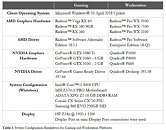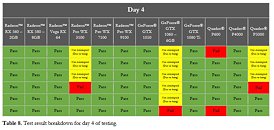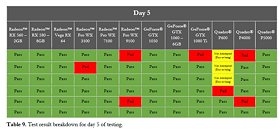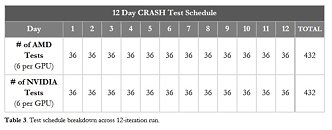Monday, July 16th 2018

QA Consultants Determines AMD's Most Stable Graphics Drivers in the Industry
As independent third-party experts in the software quality assurance and testing industry for over 20 years, QA Consultants has conducted over 5,000+ mission-critical projects and has extensive testing experience and depth in various industries. Based in Toronto, Ontario, QA Consultants is the largest on-shore software quality assurance company, with a 30,000 sq. ft., industry-grade facility called The Test Factory.Commissioned by AMD, QA Consultants used Microsoft's Windows Hardware Lab Kit (HLK) to conduct a 12-day head-to-head test comparing AMD and Nvidia graphics drivers. The test compared 12 GPU's, six from AMD and six from NVIDIA, running on 12 identical machines. All machines were configured with Windows 10 April 2018 Update. Both gaming and professional GPUs were equally represented in the testing. After running for 12 days of 24-hour stress tests, the aggregate of AMD products passed 93% of the scheduled tests. The aggregate of NVIDIA products passed 82% of the scheduled tests. Based on the results of testing the 12 GPUs, QA Consultants concludes that AMD has the most stable graphics driver in the industry.
Sources:
QA Consultants, Graphics Driver Stability Report
About QA Consultants
QA Consultants is the North American leader in software quality assurance and testing services. Having successfully delivered over 5,000 testing and consulting projects to a variety of sectors including automotive and transportation, advertising and marketing, banking and finance, construction, media and entertainment, US & Canadian Federal State and Local government, healthcare, insurance, retail, hospitality, and telecommunications.
The Test Factory is the next generation of software testing, providing a superior quality, cost and service alternative to offshore providers and external contractors. The centre can handle any testing project of any size, with any application and for any industry. With full-time employees in Toronto, Ottawa and Dallas, QA Consultants supports customers by providing testing services such as accessibility testing, agile testing, test automation, data testing, functional testing, integration testing, mobility testing, performance testing, and security testing. Along with engagement models like Managed Consulting Services and On Demand Testing , QA Consultants is equipped to handle any client's request.





124 Comments on QA Consultants Determines AMD's Most Stable Graphics Drivers in the Industry
There are a lot of fails that are not fails but runs 'Not attempted (due to hang)'. It just so happens that AMD cards have 10 of these and Nvidia cards 40. These do not represent the quality but luck - better if driver hangs later in the automated test run.
I would be much more interested in why the drivers failed.
Still, wth am I reading here? The tests are not described at all. We pass/fail per day? What is this? Were some tests passing one day only to fail the day after that? The whole report is mostly 100 pages of listing configurations :wtf:
Edit: I see now, they cherry-picked the stress test out of the whole suite. Well, if that's what floats AMD's boat...
"Mission-critical test", so you just (randomly) grab newest drivers from both side? You'd be fired if you do such bullshit on a corporate server.
The configuration of a production environment is strictly controlled in every corporation. Configurations must be intensely tested prior to installation, and tweaked, if necessary. After a configuration passed such tests, this is where "stability" kicks in -- is such success steadily reproducible in the following runs?
What these researchers did, IMHO, is that they identified 6 erroneous configurations, and superior out-of-box usability of AMD cards. Not a single shit to do with "mission-critical" stability.
On the other hand they used MSI RX580 GAMING and ASUS STRIX RX560.
Also LegitReviews asked to QA Consultants if their samples were supplied by AMD and the answer is YES : www.legitreviews.com/amd-claims-to-have-worlds-most-stable-driver-but-supplied-all-graphics-cards-tested_206705
But not the whole suite, just the stress test portion of it.
Not that it bothers me. Although, I am glad they are going to keep Vega around for a bit longer on the AI/Compute side of things. Us Vega adopters might get some of that R&D thrown our way.
They had 12 systems. 1-6 runs were done. GPU swap (AMD/Nvidia) to eliminate system bias. Then 7-12 runs.
If your alluding to driver overlap issues it would affect both. If there was any.
Most of the GeForce issues happened before the swap on runs 1-6. Funny enough after the swap the 1060 only had 1 fail.
OpenCL isn't particularly hard to implement. It's more that with CPUs having so many idle cores these days, it makes more sense to multithread the code on the CPU.
Not brand new, but fairly recent. There are tests where 1060 pulls ahead of the 580, which shouldn't be the case.
The Radeon cards are being held back by the memory subsystem. In tests where memory performance isn't the bottleneck, the Radeon cards do well. In instances where it is, they perform poorly.
Still, this isn't my point. There's an open standard out there for compute and NVIDIA deliberately doesn't update it because they would rather promote their proprietary solution (just like G-SYNC).
OpenCL 2.0 features a new shared memory subsystem that vastly accelerates memory accesses:
www.anandtech.com/show/7161/khronos-siggraph-2013-opengl-44-opencl-20-opencl-12-spir-announced/3
I wouldn't be surprised if AMD jumped on OpenCL 2.0 for that reason and NVIDIA are dragging their heels because it makes CUDA look bad.
Not seeing any benchmarks that compare OpenCL 1.2 and OpenCL 2.0 performance.
Feel free to browse that website, the guy did tons of OpenCL tests over time. I'm at work now, I posted the first thing I could find, I can't look more closely.
And stability is only part of the picture of a good driver, annoying bugs and how quickly they are fixed, how often they are updated(it can be too often as well as not often enough), etc. And again, as someone that uses drivers from both sides daily, I'm going to say right now they are both about even. I can not honestly say I prefer one over the other as they are today.
On top of that, the test they picked doesn't seem to be marked as very relevant by Microsoft: "To qualify for the Windows Hardware Compatibility Program, your product must pass certain tests using the Windows HLK." All the tested cards qualify (they have WHQL drivers), but all of them fail that test from time to time. So this test isn't one of the tests needed to qualify.
Long story short: "independent" test between two competitors, paid by one of them, looking at one specific aspect - the very definition of throwaway data.